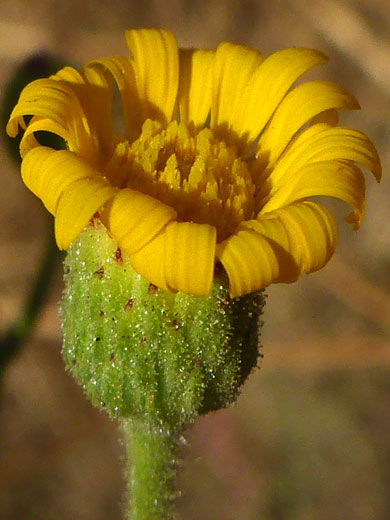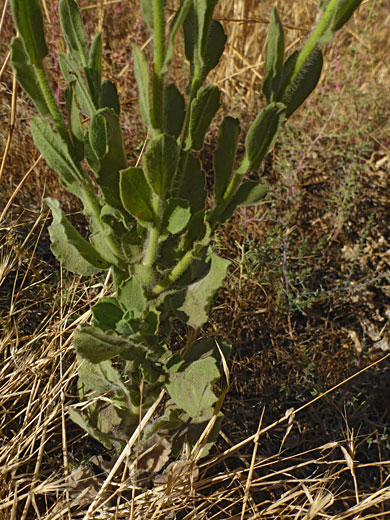Common names:
Telegraphweed, silk-grass goldenaster
Family:
Scientific name:
Heterotheca grandiflora
Main flower color:
Range:
California, south Nevada, far southwest Utah and west Arizona
Height:
Up to 8 feet
Habitat:
Roadsides, disturbed ground, fields, sand dunes, dry washes, gravelly places, from sea level to 3,000 feet
Leaves:
Ovate to oblong to lanceolate, up to 3 inches long and 1 inch across, with strigose surfaces and toothed margins
Season:
April to December
Basal and lower stem leaves, ovate to oblong in shape, of heterotheca grandiflora are attached by stalks, up to 2.5 inches long, while upper stem leaves are sessile, narrower, and lanceolate. Plants produce one to five stems, several feet high - though coastal dune populations are much shorter. Stems are hairy, and glandular, and they branch towards the top. Leaf margins may be entire but are usually coarsely to finely toothed, and ciliate. Leaf margins are often somewhat wavy.
The inflorescence is an open cluster, with ten to over 100 heads. Inflorescence branches are ascending. Flowerheads are formed of 20 to 40 yellow ray florets and 30 to 70 disc florets. Involucres are widely bell-shaped, or almost hemispherical. Phyllaries are narrowly lanceolate, of varying lengths, densely covered by head-shaped glands.
The inflorescence is an open cluster, with ten to over 100 heads. Inflorescence branches are ascending. Flowerheads are formed of 20 to 40 yellow ray florets and 30 to 70 disc florets. Involucres are widely bell-shaped, or almost hemispherical. Phyllaries are narrowly lanceolate, of varying lengths, densely covered by head-shaped glands.
All Contents © Copyright The American Southwest | Comments and Questions | Contribute | Site Map





